

Compact Muon Solenoid
LHC, CERN
| CMS-PAS-HIG-17-032 | ||
| Search for resonant double Higgs production with bˉbZZ∗ decays in the bˉbℓℓνν final state | ||
| CMS Collaboration | ||
| November 2018 | ||
| Abstract: A search for the resonant double Higgs boson production is performed using 2016 data collected with the CMS experiment at √s= 13 TeV corresponding to an integrated luminosity of 35.9 fb−1. Events in which one Higgs boson decays to a pair of b quarks, and the other Higgs boson to a pair of Z bosons are studied. Decays to electron and muon pairs are selected to reconstruct an on-shell Z boson, while the other Z boson is allowed to be off-shell and required to decay to neutrinos: X→HH→bˉbZZ∗→bˉbℓℓνν. Limits are set on the resonant double Higgs boson production cross section for a resonance with a mass in the range from 250 to 1000 GeV for spin 0 and spin 2 hypotheses. | ||
| Links: CDS record (PDF) ; inSPIRE record ; CADI line (restricted) ; | ||
| Figures | |
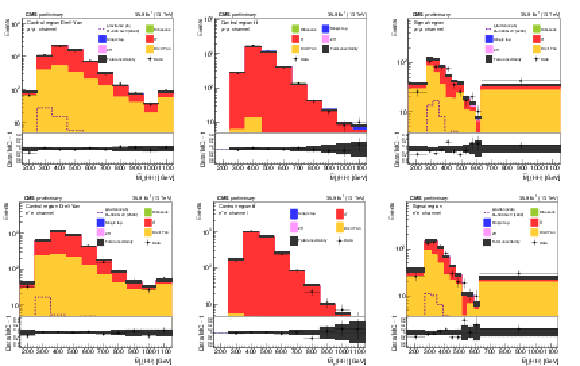
png pdf |
Figure 1:
Transverse mass of the reconstructed HH candidates for data, the simulated signal graviton sample for the 300 GeV mass hypothesis, and simulated backgrounds scaled according to the fit results. The top row shows the figures for the muon channel while the bottom row is for the electron channel. For each row, the left plot is for the Drell-Yan control region, the middle is for the t¯t control region, and the right is for the signal region. Signal normalization choice is discussed in the text. The crosshatched area represents the sum of statistical and systematic uncertainties. |

png pdf |
Figure 1-a:
Transverse mass of the reconstructed HH candidates for data, the simulated signal graviton sample for the 300 GeV mass hypothesis, and simulated backgrounds scaled according to the fit results, in the Drell-Yan control region, for the muon channel. Signal normalization choice is discussed in the text. The crosshatched area represents the sum of statistical and systematic uncertainties. |
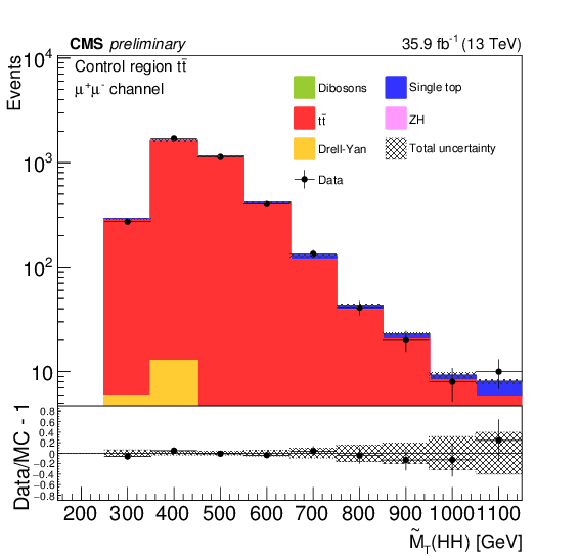
png pdf |
Figure 1-b:
Transverse mass of the reconstructed HH candidates for data, the simulated signal graviton sample for the 300 GeV mass hypothesis, and simulated backgrounds scaled according to the fit results, in the t¯t control region, for the muon channel. Signal normalization choice is discussed in the text. The crosshatched area represents the sum of statistical and systematic uncertainties. |
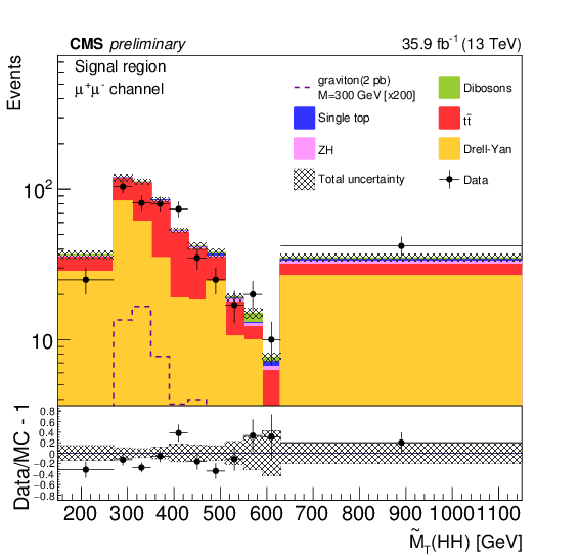
png pdf |
Figure 1-c:
Transverse mass of the reconstructed HH candidates for data, the simulated signal graviton sample for the 300 GeV mass hypothesis, and simulated backgrounds scaled according to the fit results, in the signal region, for the muon channel. Signal normalization choice is discussed in the text. The crosshatched area represents the sum of statistical and systematic uncertainties. |

png pdf |
Figure 1-d:
Transverse mass of the reconstructed HH candidates for data, the simulated signal graviton sample for the 300 GeV mass hypothesis, and simulated backgrounds scaled according to the fit results, in the Drell-Yan control region, for the electron channel. Signal normalization choice is discussed in the text. The crosshatched area represents the sum of statistical and systematic uncertainties. |
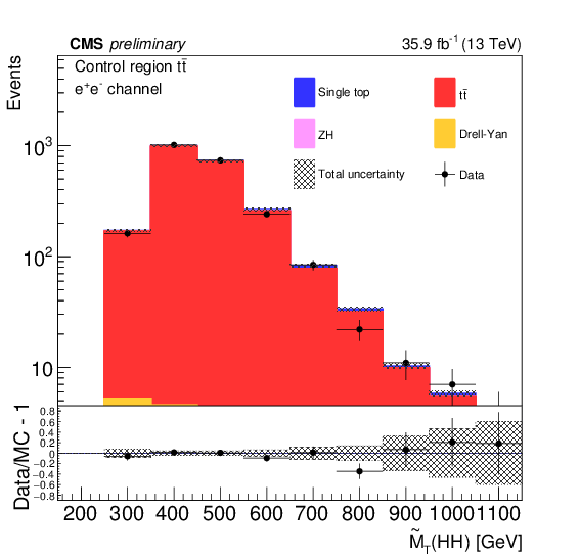
png pdf |
Figure 1-e:
Transverse mass of the reconstructed HH candidates for data, the simulated signal graviton sample for the 300 GeV mass hypothesis, and simulated backgrounds scaled according to the fit results, t¯t control region, for the electron channel. Signal normalization choice is discussed in the text. The crosshatched area represents the sum of statistical and systematic uncertainties. |
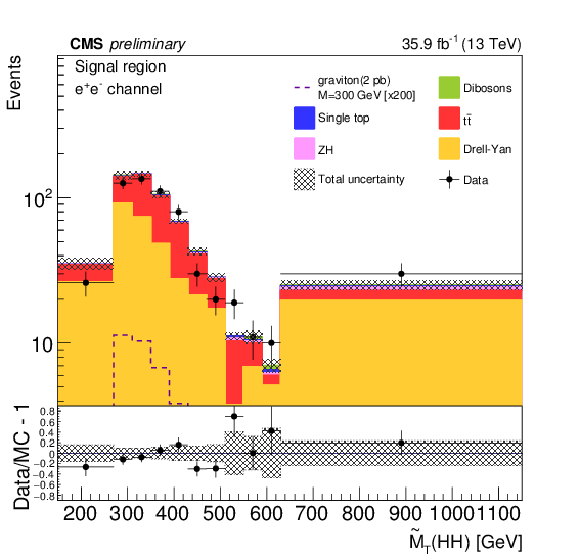
png pdf |
Figure 1-f:
Transverse mass of the reconstructed HH candidates for data, the simulated signal graviton sample for the 300 GeV mass hypothesis, and simulated backgrounds scaled according to the fit results, signal region, for the electron channel. Signal normalization choice is discussed in the text. The crosshatched area represents the sum of statistical and systematic uncertainties. |

png pdf |
Figure 2:
Transverse mass of the reconstructed HH candidates for data, the simulated signal radion sample for the 300 GeV mass hypothesis, and simulated backgrounds scaled according to the fit results. The top row shows the plots for the muon channel while the bottom row is for the electron channel. For each row, the left plot is for the Drell-Yan control region, the middle is for the t¯t control region, and the right is for the signal region. Signal normalization choice is discussed in the text. The crosshatched area represents the sum of statistical and systematic uncertainties. |

png pdf |
Figure 2-a:
Transverse mass of the reconstructed HH candidates for data, the simulated signal radion sample for the 300 GeV mass hypothesis, and simulated backgrounds scaled according to the fit results, in the Drell-Yan control region, for the muon channel. Signal normalization choice is discussed in the text. The crosshatched area represents the sum of statistical and systematic uncertainties. |
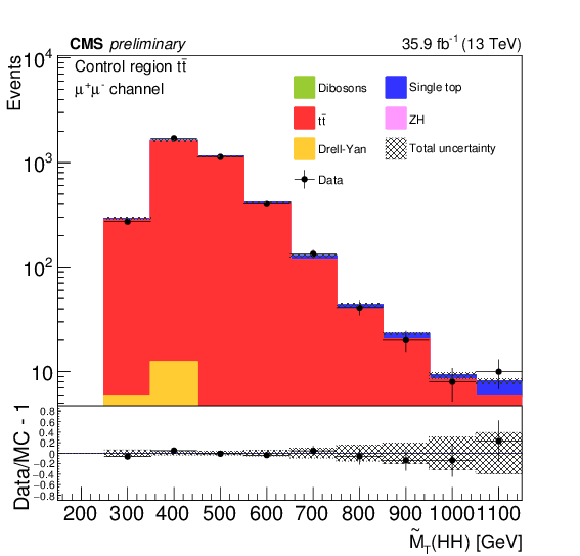
png pdf |
Figure 2-b:
Transverse mass of the reconstructed HH candidates for data, the simulated signal radion sample for the 300 GeV mass hypothesis, and simulated backgrounds scaled according to the fit results, in the t¯t control region, for the muon channel. Signal normalization choice is discussed in the text. The crosshatched area represents the sum of statistical and systematic uncertainties. |
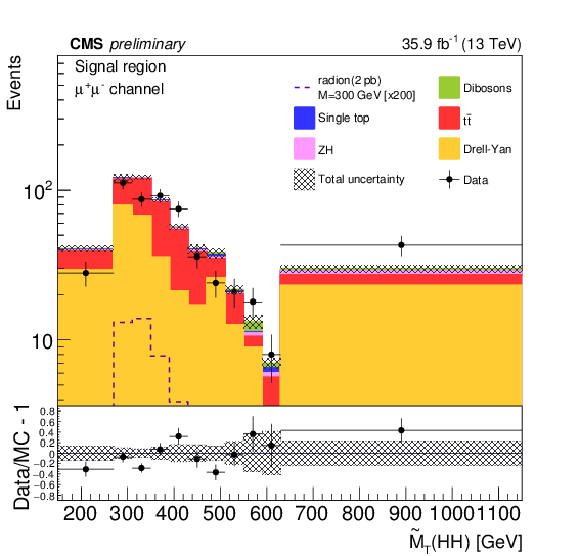
png pdf |
Figure 2-c:
Transverse mass of the reconstructed HH candidates for data, the simulated signal radion sample for the 300 GeV mass hypothesis, and simulated backgrounds scaled according to the fit results, in the signal region, for the muon channel. Signal normalization choice is discussed in the text. The crosshatched area represents the sum of statistical and systematic uncertainties. |

png pdf |
Figure 2-d:
Transverse mass of the reconstructed HH candidates for data, the simulated signal radion sample for the 300 GeV mass hypothesis, and simulated backgrounds scaled according to the fit results, in the Drell-Yan control region, for the electron channel. Signal normalization choice is discussed in the text. The crosshatched area represents the sum of statistical and systematic uncertainties. |

png pdf |
Figure 2-e:
Transverse mass of the reconstructed HH candidates for data, the simulated signal radion sample for the 300 GeV mass hypothesis, and simulated backgrounds scaled according to the fit results, in the t¯t control region, for the electron channel. Signal normalization choice is discussed in the text. The crosshatched area represents the sum of statistical and systematic uncertainties. |
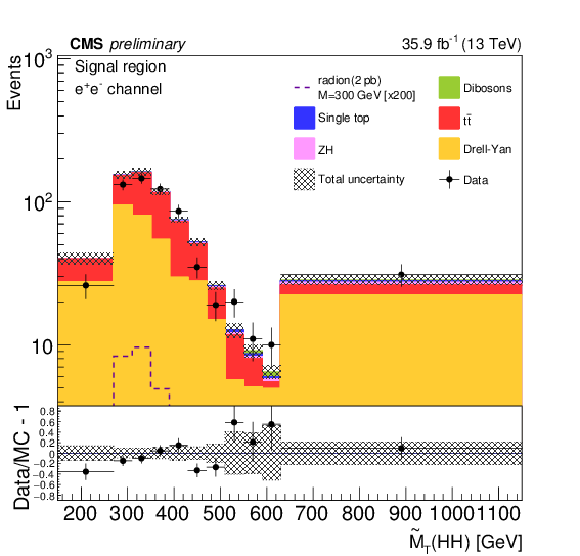
png pdf |
Figure 2-f:
Transverse mass of the reconstructed HH candidates for data, the simulated signal radion sample for the 300 GeV mass hypothesis, and simulated backgrounds scaled according to the fit results, in the signal region, for the electron channel. Signal normalization choice is discussed in the text. The crosshatched area represents the sum of statistical and systematic uncertainties. |
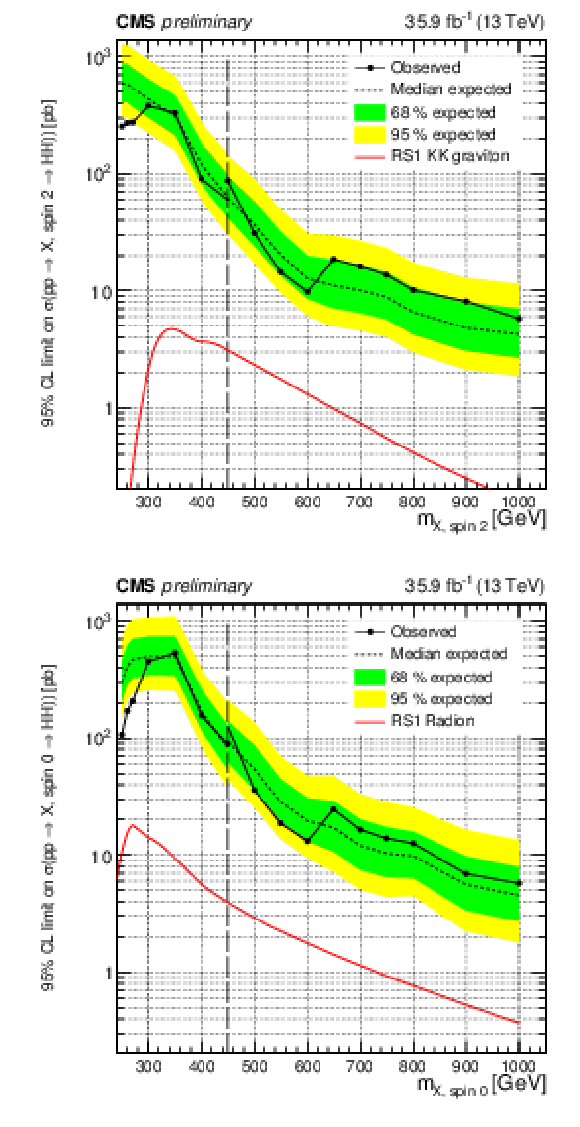
png pdf |
Figure 3:
Expected (dashed line) and observed (solid line) limits on the cross section of a resonant HH production as a function of the mass of the narrow resonance for both leptonic channels combined. Graviton case is shown at the top and radion case at the bottom. The red line shows a theoretical prediction for the production of a Warped Extra Dimensions particle with certain model assumptions [14]. |
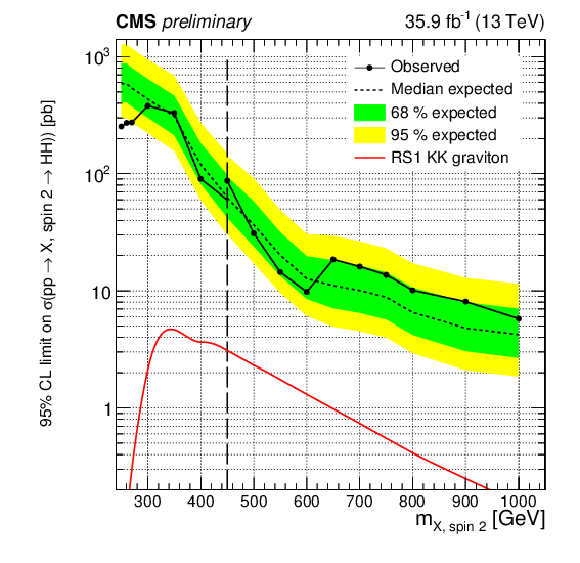
png pdf |
Figure 3-a:
Expected (dashed line) and observed (solid line) limits on the cross section of a resonant HH production as a function of the mass of the narrow resonance for both leptonic channels combined. Shown is the graviton case. The red line shows a theoretical prediction for the production of a Warped Extra Dimensions particle with certain model assumptions [14]. |

png pdf |
Figure 3-b:
Expected (dashed line) and observed (solid line) limits on the cross section of a resonant HH production as a function of the mass of the narrow resonance for both leptonic channels combined. Shown is the radion case. The red line shows a theoretical prediction for the production of a Warped Extra Dimensions particle with certain model assumptions [14]. |
| Tables | |
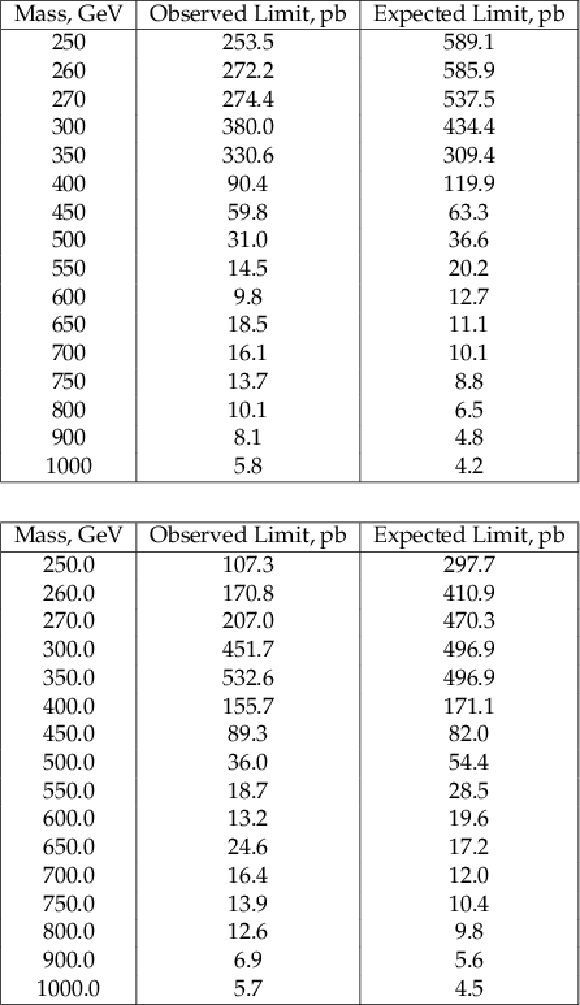
png pdf |
Table 1:
The expected and observed HH production cross section upper limits at 95% CL for different narrow resonance graviton (top) and radion (bottom) mass hypotheses for both dielectron and dimuon channels combined. |
| Summary |
|
This note presents a search for the production of two Higgs bosons through narrow resonances, a KK graviton (spin-2) and a radion (spin-0), where one of the Higgs bosons decays to two b quarks while the other decays to a pair of Z bosons which, in turn, decay to a pair of neutrinos and a pair of electrons or muons. The search is performed with the 35.9 fb−1 of 2016 data set collected by the CMS experiment at the LHC in proton-proton collisions at √s= 13 TeV. No statistically significant deviations from the SM predictions for background processes have been observed, and 95% upper confidence limits are reported for production cross section of a KK graviton/radion times the branching fraction of the subsequent decay into an HH system. The limits are derived for resonance masses in the 250 GeV to 1 TeV range. |
| References | ||||
| 1 | CMS Collaboration | Observation of a new boson at a mass of 125 GeV with the CMS experiment at the LHC | PLB 716 (2012) 30 | CMS-HIG-12-028 1207.7235 |
| 2 | ATLAS Collaboration | Observation of a new particle in the search for the Standard Model Higgs boson with the ATLAS detector at the LHC | PLB 716 (2012) 1 | 1207.7214 |
| 3 | A. Salam and J. C. Ward | On a gauge theory of elementary interactions | Nuovo Cim. 19 (1961) 165 | |
| 4 | S. Glashow | Partial symmetries of weak interactions | Nucl.Phys. 22 (1961) 579 | |
| 5 | S. Weinberg | A model of leptons | Phys.Rev.Lett. 19 (1967) 1264 | |
| 6 | CDF, D0 Collaboration, B. Tuchming | Higgs boson production and properties at the Tevatron | in Proceedings, 49th Rencontres de Moriond on QCD and High Energy Interactions: La Thuile, Italy, March 22-29, 2014, p. 3 2014 | 1405.5058 |
| 7 | ATLAS and CMS Collaborations | Measurements of the Higgs boson production and decay rates and constraints on its couplings from a combined ATLAS and CMS analysis of the LHC pp collision data at √s= 7 and 8 TeV | JHEP 08 (2016) 045 | 1606.02266 |
| 8 | LHC Higgs Cross Section Working Group Collaboration | Handbook of LHC Higgs Cross Sections: 4. Deciphering the Nature of the Higgs Sector | 1610.07922 | |
| 9 | S. Borowka et al. | Higgs boson pair production in gluon fusion at next-to-leading order with full top-quark mass dependence | PRL 117 (Jun, 2016) 012001 | |
| 10 | J. Grigo, K. Melnikov, and M. Steinhauser | Virtual corrections to Higgs boson pair production in the large top quark mass limit | Nucl.Phys.B 888 (2014) 17 | 1408.2422 |
| 11 | M. J. Dolan, C. Englert, and M. Spannowsky | New Physics in LHC Higgs boson pair production | PRD 87 (2013) 055002 | 1210.8166 |
| 12 | P. Huang, A. Joglekar, M. Li, and C. E. M. Wagner | Corrections to di-higgs boson production with light stops and modified higgs couplings | PRD 97 (Apr, 2018) 075001 | |
| 13 | S. Kanemura et al. | Single and double production of the Higgs boson at hadron and lepton colliders in minimal composite Higgs models | PRD 94 (2016) 015028 | 1603.05588 |
| 14 | A. Oliveira | Gravity particles from Warped Extra Dimensions, predictions for LHC | 1404.0102 | |
| 15 | L. Randall and R. Sundrum | Large mass hierarchy from a small extra dimension | PRL 83 (Oct, 1999) 3370 | |
| 16 | K. Agashe, H. Davoudiasl, G. Perez, and A. Soni | Warped Gravitons at the LHC and Beyond | PRD 76 (2007) 036006 | hep-ph/0701186 |
| 17 | A. L. Fitzpatrick, J. Kaplan, L. Randall, and L.-T. Wang | Searching for the Kaluza-Klein Graviton in Bulk RS Models | JHEP 09 (2007) 013 | hep-ph/0701150 |
| 18 | O. Antipin, D. Atwood, and A. Soni | Search for RS gravitons via W(L)W(L) decays | PLB 666 (2008) 155 | 0711.3175 |
| 19 | H. Davoudiasl, J. L. Hewett, and T. G. Rizzo | Phenomenology of the Randall-Sundrum Gauge Hierarchy Model | PRL 84 (2000) 2080 | hep-ph/9909255 |
| 20 | CMS Collaboration | The CMS trigger system | JINST 12 (2017) P01020 | CMS-TRG-12-001 1609.02366 |
| 21 | CMS Collaboration | The CMS experiment at the CERN LHC | JINST 3 (2008) S08004 | CMS-00-001 |
| 22 | J. Alwall et al. | The automated computation of tree-level and next-to-leading order differential cross sections, and their matching to parton shower simulations | JHEP 07 (2014) 079 | 1405.0301 |
| 23 | S. Alioli, P. Nason, C. Oleari, and E. Re | NLO single-top production matched with shower in POWHEG: s- and t-channel contributions | JHEP 09 (2009) 111 | 0907.4076 |
| 24 | P. Nason | A New method for combining NLO QCD with shower Monte Carlo algorithms | JHEP 11 (2004) 040 | hep-ph/0409146 |
| 25 | S. Frixione, P. Nason, and C. Oleari | Matching NLO QCD computations with Parton Shower simulations: the POWHEG method | JHEP 11 (2007) 070 | 0709.2092 |
| 26 | S. Alioli, P. Nason, C. Oleari, and E. Re | A general framework for implementing NLO calculations in shower Monte Carlo programs: the POWHEG BOX | JHEP 06 (2010) 043 | 1002.2581 |
| 27 | J. Alwall et al. | Comparative study of various algorithms for the merging of parton showers and matrix elements in hadronic collisions | EPJC 53 (2008) 473 | 0706.2569 |
| 28 | S. Kallweit et al. | NLO QCD+EW predictions for V + jets including off-shell vector-boson decays and multijet merging | JHEP 04 (2016) 021 | 1511.08692 |
| 29 | T. Sjostrand, S. Mrenna, and P. Z. Skands | A Brief Introduction to PYTHIA 8.1 | CPC 178 (2008) 852 | 0710.3820 |
| 30 | T. Sjostrand et al. | An Introduction to PYTHIA 8.2 | CPC 191 (2015) 159--177 | 1410.3012 |
| 31 | R. Frederix and S. Frixione | Merging meets matching in MC@NLO | JHEP 12 (2012) 061 | 1209.6215 |
| 32 | N. Kidonakis | Differential and total cross sections for top pair and single top production | arXiv:1205.3453, Kennesaw State University, May, 2012 Comments: 4 pages, 10 figures; presented at XX International Workshop on Deep-Inelastic Scattering and Related Subjects (DIS2012), Bonn, Germany, March 26-30 | |
| 33 | M. Czakon, P. Fiedler, and A. Mitov | Total Top-Quark Pair-Production Cross Section at Hadron Colliders Through O(α4S) | PRL 110 (2013) 252004 | 1303.6254 |
| 34 | CMS Collaboration | Measurements of the pp→WZ inclusive and differential production cross section and constraints on charged anomalous triple gauge couplings at √s= 13 TeV. | CMS-PAS-SMP-18-002 | CMS-PAS-SMP-18-002 |
| 35 | CMS Collaboration | Measurement of the WW cross section pp collisions at sqrt(s)=13 TeV | CMS-PAS-SMP-16-006 | CMS-PAS-SMP-16-006 |
| 36 | CMS Collaboration | Measurement of the ZZ production cross section and Z →ℓ+ℓ−ℓ′+ℓ′− branching fraction in pp collisions at √s= 13 TeV | PLB 763 (2016) 280 | CMS-SMP-16-001 1607.08834 |
| 37 | J. M. Campbell and R. K. Ellis | MCFM for the Tevatron and the LHC | NPPS 205 (2010) 10 | 1007.3492 |
| 38 | NNPDF Collaboration | Parton distributions for the LHC Run II | JHEP 04 (2015) 040 | 1410.8849 |
| 39 | CMS Collaboration | Event generator tunes obtained from underlying event and multiparton scattering measurements | EPJC 76 (2016) 155 | CMS-GEN-14-001 1512.00815 |
| 40 | GEANT4 Collaboration | GEANT4---a simulation toolkit | NIMA 506 (2003) 250 | |
| 41 | M. Cacciari, G. P. Salam, and G. Soyez | The anti-kt jet clustering algorithm | JHEP 04 (2008) 063 | 0802.1189 |
| 42 | M. Cacciari, G. P. Salam, and G. Soyez | FastJet user manual | EPJC 72 (2012) 1896 | 1111.6097 |
| 43 | CMS Collaboration | Particle-flow reconstruction and global event description with the cms detector | JINST 12 (2017) P10003 | CMS-PRF-14-001 1706.04965 |
| 44 | CMS Collaboration | Performance of CMS muon reconstruction in pp collision events at √s= 7 TeV | JINST 7 (2012) P10002 | CMS-MUO-10-004 1206.4071 |
| 45 | CMS Collaboration | Performance of electron reconstruction and selection with the CMS detector in proton-proton collisions at √s= 8 TeV | JINST 10 (2015) P06005 | CMS-EGM-13-001 1502.02701 |
| 46 | M. Cacciari, G. P. Salam, and G. Soyez | FastJet User Manual | EPJC 72 (2012) 1896 | 1111.6097 |
| 47 | M. Cacciari and G. P. Salam | Dispelling the N3 myth for the kt jet-finder | PLB 641 (2006) 57 | hep-ph/0512210 |
| 48 | CMS Collaboration | Identification of b quark jets at the CMS Experiment in the LHC Run 2 | CMS-PAS-BTV-15-001 | CMS-PAS-BTV-15-001 |
| 49 | CMS Collaboration | Particle-Flow Event Reconstruction in CMS and Performance for Jets, Taus, and MET | CDS | |
| 50 | CMS Collaboration | Search for resonant and nonresonant Higgs boson pair production in the bbℓνℓν final state in proton-proton collisions at sqrt(s) = 13 TeV | JHEP (01, 2018) 054 | CMS-HIG-15-002 1606.02266 |
| 51 | A. Hocker et al. | TMVA - Toolkit for Multivariate Data Analysis | PoS ACAT (2007) 040 | physics/0703039 |
| 52 | J. H. Friedman | Greedy function approximation: A gradient boosting machine. | Ann. Statist. 29 (10, 2001) 1189 | |
| 53 | G. Zech | Upper Limits in Experiments with Background Or Measurement Errors | NIMA 277 (1989) 608 | |
| 54 | CMS Collaboration | CMS Luminosity Measurements for the 2016 Data Taking Period | CMS-PAS-LUM-17-001 | CMS-PAS-LUM-17-001 |
| 55 | M. Botje et al. | The PDF4LHC Working Group Interim Recommendations | 1101.0538 | |
| 56 | S. Alekhin et al. | The PDF4LHC Working Group Interim Report | 1101.0536 | |
| 57 | T. Junk | Confidence level computation for combining searches with small statistics | Nucl.Instrum.Meth. A 434 (1999) 435 | hep-ex/9902006 |
| 58 | A. L. Read | Presentation of search results: the CLs technique | JPG: Nucl. Part. Phys. 28 (2002) | |
| 59 | CMS Collaboration | SM Higgs Combination | CDS | |

|
Compact Muon Solenoid LHC, CERN |

|

|

|

|

|

|